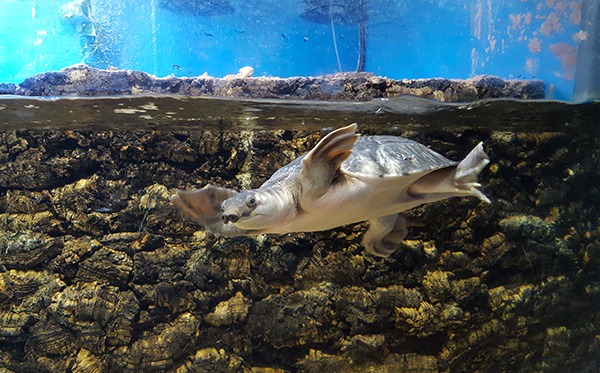Fly River Turtles

We have some new animals on display in our aquarium section called fly river turtles (Carettochelys insculpta) who are also known as pig-nosed turtles. We have a male and a female who have been off show whilst their new tank was being prepared. As soon as their new home was ready the male was moved over first to be able to establish his territory and then the female was moved over to join him.
The fly river turtle is native to Southern Papua New Guinea and Northern Australia and can be found in fresh water habitats such as rivers, streams and lakes. They are very well adapted to their aquatic lifestyle by having a streamlined carapace (shell) and limbs that are able to propel and steer their bodies through the water with ease making them excellent swimmers. Although they are an aquatic species, females will leave the water to nest on land.
Females will usually nest in the dry season and will lay up to 2 clutches per year. They build their nest at night in mud or sand close to the water and lay up to 39 eggs. The sex of the offspring is determined by the temperature at which the eggs are incubated. High temperatures produce females and low temperatures produce males. Incubation of the eggs can be between 64-102 days and when hatched the young measure between 5-6cm in length.
The carapace of these turtles can reach up to 70cm in length and they can weigh up to 30kg. Males are usually smaller than the females and have a longer, thicker tail. Their shell lacks the horny scales like other turtles and is instead covered by soft leathery skin which is usually dark grey or brown.
These turtles get the name pig-nosed from their long fleshy pig-like snout which can act like a snorkel whilst they are swimming. Their snouts also have sensory receptors which are used to help locate prey. They have an omnivorous diet varying from aquatic plants and riverside vegetation to insects, crustaceans and fish.
They are classed as vulnerable by the International Union for Conservation of Nature (IUCN) red list and are threatened by habitat loss, overharvesting for their meat and eggs and from being used in the international pet trade.
By Michelle Dennis
Education Assistant


